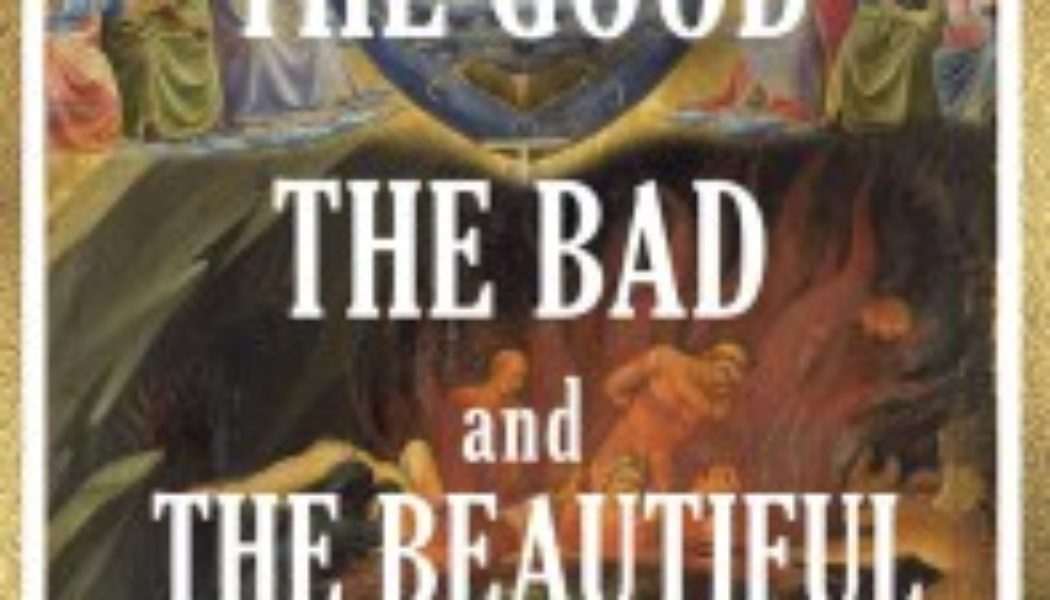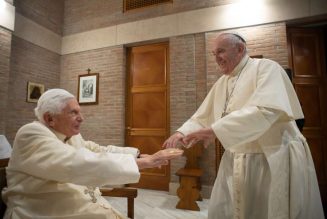Not just as a Protestant, but as an American, I am not used to having history presented to me from a Catholic point of view. Here are four things Joseph Pearce’s “The Good, the Bad, and the Beautiful” taught me, and can teach Christians of all denominations, particularly evangelicals.
The Good, the Bad, and the Beautiful: History in Three Dimensions, by Joseph Pearce (300 pages, Ignatius Press, 2023)
 While working on my doctorate at the University of Michigan, I lived for several years in a graduate dormitory that housed many international students. I still remember vividly when I walked down the hall to visit a student from Japan. She had a map of the world hanging on her wall; the moment I looked at it, my own world was turned upside down. For at the center of her map was not Africa or, as I was used to seeing it growing up, the United States, but Japan!
While working on my doctorate at the University of Michigan, I lived for several years in a graduate dormitory that housed many international students. I still remember vividly when I walked down the hall to visit a student from Japan. She had a map of the world hanging on her wall; the moment I looked at it, my own world was turned upside down. For at the center of her map was not Africa or, as I was used to seeing it growing up, the United States, but Japan!
I felt a similar sense of topsy-turvy when I, an evangelical Baptist who was raised Greek Orthodox, read Joseph Pearce’s historical tour de force of Catholic Christendom, The Good, the Bad, and the Beautiful: History in Three Dimensions. Wait a minute! Are you telling me that Mary Tudor was the heroine and Elizabeth I the villainess? That’s not the way I learned it! Were those brave proto-Protestants Wycliffe and Huss heretics and schismatics? Were they the bad guys and Joan of Arc the saint? Did the Eastern Orthodox Church become adulterated with monophysitism and iconoclasm while the Western Catholic Church maintained purer doctrine? I knew that Henry VIII had treacherously dissolved the monasteries in England, but did Luther’s ideas really lead to the German Peasant’s War?
Not just as a Protestant, but as an American, I was not used to having history presented to me from a Catholic point of view. To be honest, I disagreed with quite a few of Pearce’s points, perspectives, and interpretations. But that is not the reason I am writing this review. I write not to criticize but to celebrate. The Good, the Bad, and the Beautiful has much to teach Christians of all denominations, particularly evangelicals. Here are four things it taught me.
First, Pearce highlights again and again how threats from within have proved more deadly to Christendom than those from without. As the Romans had been Hellenized by Greek culture and the Barbarians Romanized by Roman culture, so many of the converts to Christianity were more attracted to cultural than doctrinal Christianity. After religious toleration was guaranteed by Constantine by the Edict of Milan (313), it became
socially respectable to be a Christian. In consequence, many people would become Christian for worldly reasons without really being bona fide believers. Their faith was weak, confused, and tainted with pagan superstition. Many were nominally Christian while continuing to practice the hedonistic lifestyles that had become increasingly prevalent as the empire succumbed to cultural decadence. Having withstood the power of the world when the world had sought to take it by force, the Church faced the danger of being seduced by worldliness from within. (50)
Though Pearce does not advocate persecution, he does not overlook the many times in history that the Church has grown lax in her faith and practice. As Dante does in his Commedia, Pearce celebrates the orders started by Benedict, Francis, and Dominic, but does not shy away from exposing periods of priestly concupiscence and simony.
Pearce also balances praise for the Church’s preservation of orthodoxy with censure for how often in the first millennium weakly-catechized “Christian” emperors slid into Arianism. Among the laity, many, equally weak in their knowledge of the faith, embraced the heretical teachings of the British monk Pelagius, who, Pearce explains,
denied the doctrine of Original Sin, believing that man was incorrupt in his nature. Pelagius taught that the believer in Christ could earn the reward of heaven through the triumph of the will by simply doing what Christ commanded. There was no need for supernatural assistance and, in consequence, no need for the sacraments of the Church and the grace they bestow. Although Pelagianism was countered and condemned by the Church, it has proved resilient. As the progenitor of the self-help “spirituality” so prevalent today, it continues to lead souls astray. (62-63)
Indeed, in a highly original reading of Beowulf, Pearce argues that the anonymous British monk who wrote the epic meant it, in part, to offer a criticism of Pelagianism. When Beowulf faces Grendel, he relies on his own strength rather than that of God. When he seeks out Grendel’s mother in the haunted mere, he puts his trust in a man-made sword, which proves unable to protect him from the supernatural evil that lurks within.
Beowulf “would most certainly have been killed had not a magical sword miraculously appeared within his grasp…. The moral and theological message is clear enough. No human person, however strong, can defeat the power of evil without supernatural assistance (grace), nor can the most powerful works of human ingenuity (the man-made sword signifying what we would now call technology) save us from evil” (102). Salvation by grace did not have to await the Protestant Reformation. It was understood and fought for by theologians and councils across the centuries.
Which does not mean that the Church has downplayed the central role of piety in the lives of individual believers and of the Body of Christ. Pearce introduces his readers to dozens of saints who lived lives of great spiritual purity and discipline. In particular, and this was my second take away from The Good, the Bad, and the Beautiful, Pearce shines a spotlight on the godly women of the Church. As my Baptist denomination struggles hard to resist angry demands for the ordination of women—to which nearly all mainline Protestant denominations have succumbed—the church catholic needs to be reminded that the Catholic Church, while maintaining the traditional ban on priestesses, has always held her female saints in high esteem.
The portraits that Pearce paints of these remarkable women offer our society what it desperately needs: a vision of femininity that is at once strong and gentle, courageous and submissive. Consider these role models of feminine virtue:
- Hildegard of Bingen was a “woman of astonishing genius” who wrote innovative Church music and “the first morality play… Pope Benedict XVI, in 2012, proclaimed her a Doctor of the Church.” (153)
- “St. Bridget of Sweden and St. Catherine of Sienna…sought to heal the divisions in the Church through their prayers, holy example, and wisdom.” (166)
- Marjorie Kempe wrote the first autobiography in English. “It documents the trials and tribulations of marriage and motherhood but also her many pilgrimages to shrines across Christendom, including the Holy Land, and her mystical visions and conversations with Christ, which have not been formally approved by the church.” (169)
- “Julian of Norwich, a mystic and anchoress, received a number of mystical visions in 1373, centered on the Holy Trinity and the Passion of Christ.” She lived walled up in a cell, where “she spent a solitary life of prayer meditating upon the visions she had received.” (169)
Of course, the greatest godly woman is Mary herself. The third lesson I learned from Pearce’s book was the impact Marian apparitions have had over the course of Church history. Although he focuses mostly on Europe, Pearce includes major missionary movements, including those to the New World. “It was the apparition of Our Lady of Guadalupe in Mexico in 1531,” he explains, “only a decade after the conquest of the Aztec Empire by the Spanish conquistador Hernán Cortés, which opened the hearts of the indigenous people of Mexico to the new religion being preached by the Spanish missionaries” (198).
Three centuries later, while Pius IX was formulating the Immaculate Conception, his efforts were “confirmed miraculously by heaven itself in 1858 with several apparitions of the Blessed Virgin to a fourteen-year-old peasant girl, Bernadette Soubirous.” In addition to confirming the doctrine, the apparition, Pearce points out, took place in France, the country which had once been a center of Catholic influence, but which had fallen away from the faith in the wake of the Enlightenment and the French Revolution. “The Mother of the Church appears miraculously to the oldest and most rebellious of the Church’s daughters. Like her Son, she comes to call not the righteous but sinners to repentance” (241)
In 1917, Mary appeared again in Fatima, Portugal, on the eve of the Bolshevik Revolution. “In the midst of the darkest hour, in which the diabolical specter of communism was rising to spread its murderous darkness over the world, the Queen of Heaven comforted her children with the promise of the victory that her Son had already won for those who remain faithful to Him” (262). Though Protestant believers like myself tend to be skeptical about such apparitions, it cannot be denied that the timing of these three apparitions was fortuitous indeed!
Finally, as I neared the end of Pearce’s bracing Cook’s tour of Christendom, I was left feeling convinced that the last century-and-a-half of Western democracy and capitalism would have been more humane, just, and merciful had Europe and America heeded Leo XIII’s “explication of the Church’s social teaching in the encyclical Rerum Novarum (1891).” In it, Leo “gave the definitive Catholic response to socialism and to free market libertarian capitalism, especially in its elucidation of the twin pillars of subsidiarity and solidarity as the only just solution to economic and political injustice” (255).
Subsidiarity, which was championed in the distributivism of Belloc and Chesterton, both of whom Pearce quotes frequently, and which was reiterated by Pius XI in Quadragesimo Anno and John Paul II in Centesimus Annus, calls for social, political, and economic issues to be dealt with on the smallest, most local level possible. The goal is to form stronger communities of family, faith, and industry. Pearce himself called for such an approach in his Small is Still Beautiful: Economics as if Families Mattered (2006), and I, as an evangelical, second his call.
Such are the lessons I took away from Pearce’s bravura overview of the good, bad, and beautiful things that the Church Militant, and the sinners-saved-by-grace who compose her global ranks, have done with the two millennia that have been given to her since Pentecost.
The Imaginative Conservative applies the principle of appreciation to the discussion of culture and politics—we approach dialogue with magnanimity rather than with mere civility. Will you help us remain a refreshing oasis in the increasingly contentious arena of modern discourse? Please consider donating now.
The featured image, uploaded by Dosseman, is The Last Judgment” by Fra Angelico. This file is licensed under the Creative Commons Attribution-Share Alike 4.0 International license, courtesy of Wikimedia Commons









